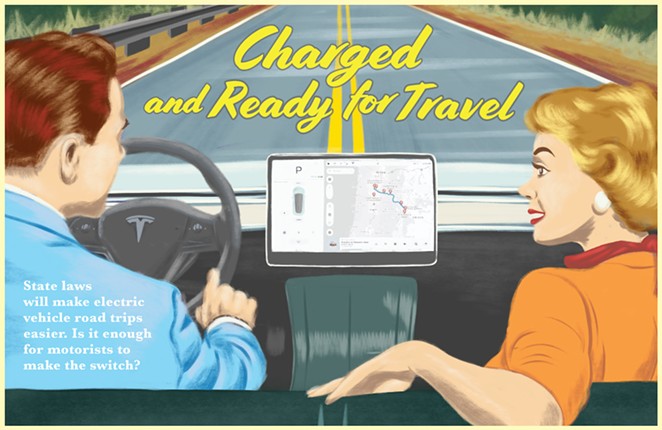Oregon has a goal of reaching 250,000 electric vehicles by 2025. In September 2023, there were 80,000 registered electric vehicles in Oregon, according to Oregon Department of Transportation Public Affairs Specialist Matt Noble. To help reach this goal, ODOT is attempting to incentivize the use of EVs by increasing access to chargers, making EV trips easier.
ODOT's new Community Charging Rebates Program will add nearly 370 new public EV charging ports across the state in 2024. Up to $7 million will go toward installing Level 2 EV charging stations, particularly in public parking sites and multi-family housing.
"We really tried to target gaps in our EV charging infrastructure with the program," said Noble. Filling these gaps means expanding access to EV chargers in rural areas and underserved communities, reducing barriers and anxieties attached to purchasing an EV.
EVs continue to grow in Oregon, with the state's EV registrations quadrupling in the last five years, according to an Oregon Department of Energy Biennial Report released in September 2023. Oregon's EV growth rate has remained around 32% since 2017.
To achieve Oregon's goal of 250,000 EVs by 2025, the state would need an average growth rate of 58.7, almost double the current rate. According to the report, increased EV adoption hinges on the installation of charging infrastructure. However, several factors continue to create hesitancy around making the switch.
Electric Vehicle Obstacles
According to Noble, certain issues that come along with owning an EV may cause some anxieties for people on the fence. Aside from affordability, one of the biggest factors is EV charger availability – a term Noble called "range anxiety." This is when individuals worry that there won't be a charger available during their trip or at their location.
An equally prominent and accurate fear that ODOT has heard from many drivers involves broken chargers. While charging stations exist, and some people might be confident their EV can reach it, the issue is now becoming whether the charger will be working when they arrive. While a rural area or road may have a few chargers along the route, they may not work, and it's often impossible for people to know.
"I think charger up-time, and how often they're actually able to serve electricity to vehicles, can be really challenging," said Noble. "There's a myriad of ways that they can break, and we have thousands of them in the state."
The weather in Oregon is a contributing factor to maintenance issues. Cold temperatures, wind and rain can all take a major toll on chargers, said Noble, especially for those sitting outside in an uncovered area.
A shortage of parts and workers also causes strain, leaving charging points unmaintained. Since COVID, service providers, and those who maintain their own EV charging network, have had trouble finding and obtaining replacement parts. Other industry problems include fewer people to service the chargers, resulting in fewer people maintaining a wide geographic area.
"Range anxiety and charging anxiety are a really big thing — I have it myself," said Aleksandra Evert, a program manager II with Forth Mobility, a Portland-based nonprofit advancing electric mobility. "The way that ODOT has structured this program is that there's a really big maintenance component to it. So that's one important thing...making sure that if somebody comes to the chargers, that it's available and online."
Better Charging Infrastructure
Over the next five years, Oregon leaders hope to navigate some of these issues and fears through the Community Charging Rebate Program, increasing the number of EV chargers along major roads and within Oregon communities. The program also reimburses private and public investments in chargers.
The additional charging ports getting built across Oregon in 2024 will be placed in several different areas. In Deschutes County alone, the program will add 34 additional charging ports. The charging ports will focus particularly on public parking sites and multi-family housing. The program looks at specific areas within rural or underserved communities – areas lacking in EV infrastructure.
"I'm really excited to continue to work with ODOT on round two because I really think that it's helping communities who are typically left behind have access to this technology, and that's really exciting," said Evert.
Other destinations receiving these charging ports include attractions like ski areas, hotels on the coast and bigger cities, making road trips less nerve-wracking. The charging areas, according to Noble, are often places where vehicles tend to spend more time. Parking lots near shopping centers, main streets, parks or other attractions often make for ideal charging points.
Electric vehicle charging ports range in type, determining how people can charge their EVs and how long it will take. A level one charger, the weakest of the three, is the only EV charging port that can be plugged into a typical grounded outlet. This type of charger, ideal for overnight charging, simply requires the charging cables that come with an EV but takes about two to three days to fully charge.
A level two charger, the most common, is the preferred all-electric car charger for all situations. This charging port requires a special outlet and can be placed at home stations or in public. "They are not as high powered as the next step up, but they are very cost effective when the vehicles spend a lot of time there. Level two will charge most EVs in six to eight hours," said Noble. A level three charger, also known as a DEC Fast Charger, is the fastest of the three and can charge an EV in less than an hour.
The chargers will sit in these areas to allow people enough time to charge their cars, given the fact that they'll all be Level 2 chargers.
All-Around Improvements
In addition to the community charging rebate program, other programs encouraging EVs will increase the availability of chargers in Oregon. Adopt a Charger and EV manufacturer Rivian recently installed charging stations at eight day-use state parks across the state.
"Prior to this project taking off, we didn't have any dedicated charging stations at state parks," said Jo Niehaus, policy advisor for Oregon Parks and Recreation. This program is the first of its kind in state parks to increase accessibility in recreation areas.
According to Niehaus, OPRD had been getting questions from the public regarding dedicated charging stations at state parks. "The opportunity to partner came at a really good time," said Niehaus. "We've been seeing a lot of use from them."
"As more used electric vehicles, without these extra-long ranges, come to the market, it's critical that we're able to make sure that all of our parks are accessible, and that people are not traveling to our parks and getting stranded because they can't charge and be able to move on to their next destination."
The official partnership kicked off in March 2022. Since it's a pilot project, Niehaus said it's not enough to cover the full need she is seeing in the field. "We're getting a lot of requests all the time. People would like to see dedicated charging stations in campgrounds," said Niehaus. "There's definitely a want and an ask to increase electrification in our parks, and this pilot project really helps us look into that and helps us strategically plan for the long run."
Oregon is receiving $52 million over the next five years from the National Electric Vehicle Infrastructure program, a federally funded program adding fast chargers in all 50 states. The program is estimated to develop or upgrade about 50 fast charging stations in the state.
The stations from this program must be no farther than 50 miles apart from each other and must be located within 1 mile of an interstate or highway exit, increasing the ease of EV charging on road trips. Oregon roads receiving NEVI funding in 2024 include Interstate 5, south of Eugene, Interstate 205 and U.S. Highway 97.
While the most recent statistic suggests that Oregon had about 80,000 registered EVs in September, Noble believes there are likely more. Oregon has about 1000 new registered EVs a month and a growing number of EVs over the last couple of years, according to Noble, indicating that more people are considering an EV for their next vehicle.
"It may be difficult to hit that goal, but I think the positive news is that we are seeing accelerated adoption rates and every year we have more chargers of all different levels," said Noble. In the next couple of years, people will see more chargers and when people have that perception that an EV can work for them, they can parlay that into a purchase down the road."























